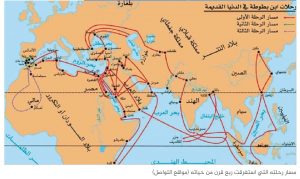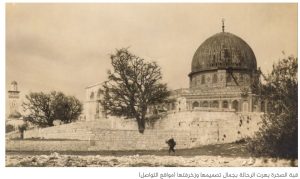Perhaps one of the funniest and most enjoyable reads by the curious about the history of a city in its antiquity is to read it through the eyes of travelers and travelers, who often write down a new, non-stereotypical image such as the one that the people of the city are accustomed to, and in their eyes it has become a state of stillness and habituation, and an environment for mere living, housing, work and stability.
In the books of travelers, geographers and tourists, the pleasure of feeling the place and its secrets, and a touch of the clear pictorial language that brings you closer to distances, and smells in it and through it the fragrant tales, monuments and buildings, and the stories of people who have been traversed by time and dirt, as if keeping pace with that sense of the old traveler in his solution, and we see and travel This creative ability to bring the image of cities, their mysteries and their charms closer hundreds of years ago, was found by one of the brightest and most famous Muslim travelers in their ancient times, the most famous Moroccan traveler Ibn Battuta.
Muhammad bin Abdullah bin Muhammad al-Lawati al-Tanji al-Maghribi, better known as Ibn Battuta, is a historian, jurist and judge. Moreover, he is “the prince of Muslim travelers” throughout their history as described by scholars of the West before the East. He resolved to perform Hajj at the age of 27, but the journey fascinated him. And he decided to set out and explore the horizons in the countries of Asia, southern Russia, the Arab countries, East Africa, Anatolia and Constantinople, and this exciting adventure took a quarter of a century of his life, until he chose to return to his homeland at the end of his life with the age of old age and the beginning of graying, deciding to record this brilliant journey in his most famous book. “The masterpiece of the spectators in the strangeness of the lands and the wonders of travel.”

His Journey to Al-Quds
Ibn Battuta did not miss visiting the most famous religious cities, as he visited Mecca and Medina, he decided to visit Jerusalem, enjoy its residence for days, get to know its most important sheikhs and scholars, and stand on its most important monuments and mosques, and writes it all in a graceful and honest language, and I stood helpless in some Sometimes he expressed his fascination with the Dome of the Rock mosque, which he saw as one of the most amazing buildings he had seen in his life.
He set out from his city of Tangier, passing through North Africa and then Egypt, which was ruled by one of the greatest Mamluk sultans at the time, Al-Nasir Muhammad bin Qalawun, whose empire extended to the Levant, Palestine, southern Anatolia, Hijaz and even northern Yemen.
From Egypt, our voyager decided to explore the cities of Palestine, starting with Gaza and then the city of Hebron, where he visited the Ibrahimi Mosque, passing near the Dead Sea and from it towards Al-Quds Al-Sharif in the first third of the 14th century AD / the eighth century AH, and was the first thing that Ibn Battuta noticed when he saw the city for the first time Its entire wall that protects it from enemy attacks is destroyed.
It is known that the medieval cities were all surrounded by walls that protected them from any emergency external invasion, including Al-Quds Al-Sharif, but Sultan Salah Al-Din Al-Ayyubi when he returned the city again from the Crusaders after the famous Battle of Hattin, decided to demolish the city wall for fear that the Crusaders would return and occupy it again They are fortified with this wall, and the Mamluk Sultan Rukn al-Din Baybars later completed the demolition of the entire wall for the same reason.
Ibn Battuta also noted that Jerusalem at that time had been built into a small water canal coming from a group of wells far from it, and the Mamluk sultans and their governors, especially the Prince of the Levant, where Jerusalem was administratively affiliated with Damascus at the time, were keen to provide means of water security for the city, which had long been divided. Its residents depend on its few wells or on waterers who bring water to it from a far place, so they decided to dig this water channel, which made it easier for the city’s residents to live.

Ibn Battuta in The Mosque And The Dome
He immediately set out for Al-Aqsa Mosque, and was impressed by it and its large area, and recorded its exact condition at the time, saying, “It is one of the wonderful, beautiful, and wonderful mosques. And its width from the qiblah to the hollow is four hundred and thirty-five cubits, and it has many doors in its three sides, and as for the tribal side of it, I only know of one door, and it is through which the imam enters, and the whole mosque is an unroofed space except Al-Aqsa Mosque, which is roofed, in the end of the provisions of the work And mastery of workmanship, camouflaged with gold and clear dyes, and in the mosque other places that are roofed.”
However, what struck him most astonishment, admiration and splendor was the Dome of the Rock mosque, which at that time was close to its state in which it is today, with its magnificent golden dome that sparkles when the sun’s rays cross it, and its exquisite blue decoration, (in addition to) its octagonal geometric construction that is alien to Islamic architecture in Morocco Especially, even in the countries of the East.
Ibn Battuta says in this mosque with admiration and astonishment, “It is one of the most amazing buildings, the most perfect and the strangest in shape. Marble is also well-worked, as well as its interior, exterior and interior of the types of glamor, and fine workmanship, which is incapable of the descriptor, and most of that is overlaid with gold; It sparkles with light, and shines with the brilliance of lightning, its beauties are bewildered by the contemplator, and the tongue of its seer falls short of representing it.”
He described the rock above which our Prophet, may God bless him and grant him peace, ascended to heaven, as he described its height, and what was below it at that time, and what was among the windows overlooking the honorable rock, saying: “And beneath it is a cave the size of a small house, its height also is about a staircase. And there is the shape of a mihrab, and on the rock are two tightly-worked windows that are closed on it: one of them is next to the rock of exquisite workmanship, and the second is of wood, and in the dome is a large shield of iron hanging there, and people claim that it is the shield of Hamza bin Abdul Muttalib, may God be pleased with him. about him”.
In the days of his stay in Jerusalem, Ibn Battuta was interested in visiting its famous places and landmarks. He referred to the tomb of Rabaa the Bedouin and confirmed that it is one of the ancient worshipers, and she is not Rabaa Al-Adawiya of Iraq. He also pointed out that the Church of the Holy Sepulcher in Jerusalem had pilgrims coming from Europe who paid a tax to enter it. He said, “And on everyone who performs Hajj there is a tax known to the Muslims, and various kinds of insults he bears despite his nose, and there is the place of the cradle of Jesus, peace be upon him, in which the Muslims receive blessings.”
Perhaps the reason why the Mamluk authorities insulted visitors to the Church of the Holy Sepulcher among pilgrims from Europe was because the Crusades had a strong presence in the memory of Muslims at the time, and that the Mamluk state itself, even the father of Sultan Al-Nasir Muhammad (Al-Mansur Qalawun) and his brother Sultan Al-Ashraf Khalil bin Qalawun, were among the late The sultans who entered into the final struggle to expel the Crusaders from the Levant, and their last and largest stronghold was the city of Acre.
Ibn Battuta met with famous scholars of Jerusalem at the time, learned from them, listened to them, memorized the names of those he met and enjoyed their conversation. We note that most of the scholars and Sufis he met were immigrants coming from different countries from the city, which was one of the most important scientific and cultural attractions at the time.
He met with Judge Shams al-Din Muhammad bin Salem al-Ghazi, and confirmed that he was “one of the people of Gaza and its lords.” He met the preacher Imad al-Din al-Nabulsi, and also the Sheikh of al-Khanqa, the authority attributed to Sultan Salah al-Din. He was a man coming from Granada in Andalusia. Jerusalem”.
Ibn Battuta also met one of the great ascetic Sufis from eastern Anatolia, Sheikh Al-Salih Al-Abed Abu Abdul Rahim Abdul-Rahman bin Mustafa from the people of the Cedars of Rome, and he was one of the students of Taj Al-Din Al-Rifai, “I accompanied him and I wore a rag from him.”
Thus, Ibn Battuta’s most famous journey preserved for us his beautiful impression of the city of Jerusalem seven centuries ago, and how its Al-Aqsa Mosque and the Dome of the Rock, its wall and the reasons for its demolition, and the most famous scholars, sheikhs and mystics who came from various far-flung countries, felt comfort, tranquility and peace in Jerusalem.
Sunna Files Free Newsletter - اشترك في جريدتنا المجانية
Stay updated with our latest reports, news, designs, and more by subscribing to our newsletter! Delivered straight to your inbox twice a month, our newsletter keeps you in the loop with the most important updates from our website












